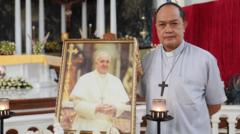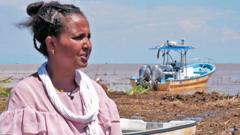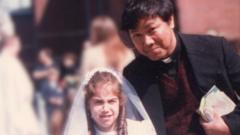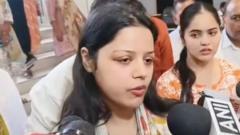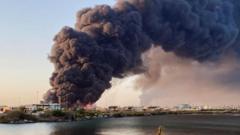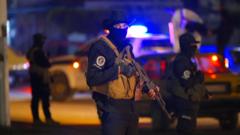As the civil war leaves a staggering toll in Syria, forensic experts and family members confront the aftermath of tragedy at the Syrian Identification Centre. The painstaking work of identifying remains from mass graves indicates that healing and justice will be a prolonged journey for those affected.
The Long Journey to Justice: Forensic Efforts to Identify Victims of Syria's Civil War
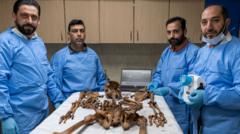
The Long Journey to Justice: Forensic Efforts to Identify Victims of Syria's Civil War
A newly established Syrian Identification Centre faces daunting challenges in identifying victims from mass graves as the country struggles with its past.
Article text:
Dr. Anas al-Hourani, head of the newly-opened Syrian Identification Centre, is amidst a grim task as he examines remains taken from mass graves scattered across Syria. “These are from a mixed mass grave,” he explains, pointing to two tables lined with 32 human femurs on each. The presence of these bones signifies the haunting legacy of the ongoing civil war, which has claimed hundreds of thousands of lives since its onset 13 years ago.
Dr. al-Hourani, a forensic odontologist, emphasizes the significance of teeth in identifying the deceased, allowing researchers to uncover critical details such as height, sex, and age. Nonetheless, challenges abound, as the only DNA testing facility in the country remains under-resourced and constrained by sanctions. Vital chemicals for testing are in short supply, and there are strict controls on dual-use items that could potentially serve military purposes.
Identifying remains from mass graves is particularly taxing: at an estimated cost of $250 for each DNA test, the financial and logistical burdens weigh heavily on the team, already reliant on assistance from the International Committee of the Red Cross. Many families await news about their lost loved ones, but the process is slow and fraught with difficulties, prompting Dr. al-Hourani to assert this work will extend for years.
Amidst the somber backdrop, Abu Ali, a former military driver, recalls his harrowing experiences transporting countless bodies during the early years of the conflict. He claims that many of these corpses were civilians, their fates linked to infamous detention centers like "Branch 215." As military vehicles repeatedly delivered their grim cargo to burial sites, Abu Ali would witness the brutality of state-sponsored violence firsthand.
Missing persons remain a constant source of anguish for families, including Malak Aoude, who has endured years of heartbreak since her two sons were taken. Mohammed, her eldest, was swept into the violent machine of the regime, while Maher disappeared from school. Despite the recent shifts in power, Malak finds herself locked in a relentless search for answers, her hopes overshadowed by the absence of closure and the apparent lack of accountability for the past.
As witnesses recount their experiences and families cling to memories, the work at the Syrian Identification Centre becomes emblematic of a broader struggle for justice in a nation afflicted by enduring pain. Together, they embody a quest for recognition, healing, and ultimately, a chance to reclaim their shattered lives.
Dr. Anas al-Hourani, head of the newly-opened Syrian Identification Centre, is amidst a grim task as he examines remains taken from mass graves scattered across Syria. “These are from a mixed mass grave,” he explains, pointing to two tables lined with 32 human femurs on each. The presence of these bones signifies the haunting legacy of the ongoing civil war, which has claimed hundreds of thousands of lives since its onset 13 years ago.
Dr. al-Hourani, a forensic odontologist, emphasizes the significance of teeth in identifying the deceased, allowing researchers to uncover critical details such as height, sex, and age. Nonetheless, challenges abound, as the only DNA testing facility in the country remains under-resourced and constrained by sanctions. Vital chemicals for testing are in short supply, and there are strict controls on dual-use items that could potentially serve military purposes.
Identifying remains from mass graves is particularly taxing: at an estimated cost of $250 for each DNA test, the financial and logistical burdens weigh heavily on the team, already reliant on assistance from the International Committee of the Red Cross. Many families await news about their lost loved ones, but the process is slow and fraught with difficulties, prompting Dr. al-Hourani to assert this work will extend for years.
Amidst the somber backdrop, Abu Ali, a former military driver, recalls his harrowing experiences transporting countless bodies during the early years of the conflict. He claims that many of these corpses were civilians, their fates linked to infamous detention centers like "Branch 215." As military vehicles repeatedly delivered their grim cargo to burial sites, Abu Ali would witness the brutality of state-sponsored violence firsthand.
Missing persons remain a constant source of anguish for families, including Malak Aoude, who has endured years of heartbreak since her two sons were taken. Mohammed, her eldest, was swept into the violent machine of the regime, while Maher disappeared from school. Despite the recent shifts in power, Malak finds herself locked in a relentless search for answers, her hopes overshadowed by the absence of closure and the apparent lack of accountability for the past.
As witnesses recount their experiences and families cling to memories, the work at the Syrian Identification Centre becomes emblematic of a broader struggle for justice in a nation afflicted by enduring pain. Together, they embody a quest for recognition, healing, and ultimately, a chance to reclaim their shattered lives.

